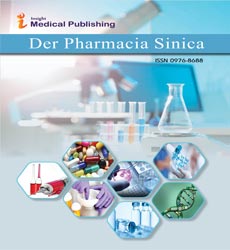ISSN : 0976 - 8688
Der Pharmacia Sinica
Green Synthesis of Metal Nanoparticles Using Medicinal Herbs: Applications in Antimicrobial Therapy
Thomson Reyold*
Department of Medicinal Chemistry, University of Sydney, Sydney, Australia
*Corresponding author:
Thomson Reyold,
Department of Medicinal Chemistry, University of Sydney, Sydney, Australia,
E-mail: thomson.rey@edu.au
Received date: January 02, 2025, Manuscript No. ipdps-25-20777; Editor assigned date: January 04, 2025, PreQC No. ipdps-25-20777 (PQ); Reviewed date: January 18, 2025, QC No. ipdps-25-20777; Revised date: January 24, 2025, Manuscript No. ipdps-25-20777 (R); Published date: January 31, 2025, DOI: 10.36648/2470-6973.16.01.04
Citation: Reyold T (2025) Green Synthesis of Metal Nanoparticles Using Medicinal Herbs: Applications in Antimicrobial Therapy. Der Pharmacia Sinica Vol.16.No.01: 04
Introduction
The rapid emergence of multidrug-resistant pathogens has intensified the need for innovative antimicrobial strategies. Metal nanoparticles such as silver, gold, zinc oxide, and copper oxide have emerged as potent antimicrobial agents due to their unique physicochemical properties, including high surface area-to-volume ratio, tunable size, and ability to generate reactive oxygen species. Traditional chemical and physical synthesis methods, however, often involve toxic reagents, high energy input, and environmentally hazardous byproducts. In response, green synthesis approaches using medicinal herbs have gained significant attention. By leveraging the bioactive compounds in plants, such as polyphenols, flavonoids, and alkaloids, researchers can reduce metal ions to nanoparticles in an eco-friendly, cost-effective, and scalable manner. This integrative approach not only addresses environmental concerns but also enhances the biological compatibility and therapeutic potential of nanoparticles for antimicrobial applications [1].
Description
Medicinal herbs are rich reservoirs of phytochemicals that serve as natural reducing and stabilizing agents in the synthesis of MNPs. The process typically involves preparing aqueous or alcoholic extracts of leaves, roots, flowers, or seeds, which are then mixed with metal salt solutions under controlled conditions of temperature, pH, and reaction time. Phytochemicals in the extract reduce metal ions to their zero-valent state, simultaneously capping and stabilizing the nanoparticles to prevent aggregation. Characterization of these biosynthesized nanoparticles using techniques such as UVâ??visible spectroscopy, X-ray diffraction, Fourier-transform infrared spectroscopy, transmission electron microscopy, and scanning electron microscopy confirms size, morphology, crystallinity, and surface functional groups. Notably, the choice of plant species and extraction method significantly influences nanoparticle size, shape, and stability, which are critical parameters for antimicrobial efficacy [2].
Green-synthesized metal nanoparticles exhibit potent antimicrobial activity against a broad spectrum of pathogens, including Gram-positive and Gram-negative bacteria, fungi, and viruses. Silver nanoparticles (AgNPs) are particularly well-studied, displaying strong inhibitory effects against Staphylococcus aureus, Escherichia coli, Pseudomonas aeruginosa, and Candida species. The antimicrobial mechanisms of MNPs are multifaceted. Nanoparticles attach to microbial cell membranes, causing structural disruption and increased permeability. They also generate reactive oxygen species, which induce oxidative stress and damage cellular components such as proteins, lipids, and DNA. Additionally, metal ions released from nanoparticles can interfere with enzymatic activity and nucleic acid synthesis, ultimately leading to microbial cell death. The synergistic effect of phytochemicals present on the nanoparticle surface can further enhance antimicrobial potency, providing a dual mode of action that reduces the likelihood of resistance development [3].
Beyond direct antimicrobial activity, green-synthesized nanoparticles offer potential for therapeutic delivery systems. Functionalization of nanoparticles with plant-derived molecules can improve targeting, bioavailability, and stability, enabling localized and sustained release of active agents. This is particularly valuable in wound healing, where nanoparticles can prevent infection while promoting tissue regeneration. Studies have demonstrated that AgNPs coated with herbal extracts accelerate wound closure, reduce microbial load, and modulate inflammatory responses. Similarly, gold nanoparticles synthesized using medicinal herbs have shown potential in drug delivery applications, including conjugation with antibiotics or natural compounds to enhance antimicrobial efficacy and minimize systemic toxicity. Such multifunctional nanoparticles exemplify the integration of nanotechnology with traditional herbal medicine for advanced biomedical applications. While the potential of herb-mediated nanoparticle synthesis is substantial, challenges remain in scaling and standardizing production for clinical application [4,5].
Conclusion
The green synthesis of metal nanoparticles using medicinal herbs represents a sustainable, effective, and innovative approach for combating microbial infections. By harnessing the reducing and stabilizing properties of phytochemicals, researchers can produce nanoparticles with enhanced antimicrobial activity, biocompatibility, and potential for multifunctional therapeutic applications. Characterization, optimization, and rigorous biological evaluation are crucial for maximizing efficacy and ensuring safety. As the threat of antimicrobial resistance continues to grow, integrating nanotechnology with traditional herbal medicine offers a promising avenue for next-generation antimicrobial therapies. Continued research and development in this field are likely to yield environmentally friendly, cost-effective, and clinically relevant solutions, bridging the gap between traditional knowledge and modern biomedical innovation.
Acknowledgement
None.
Conflict of Interest
None.
References
- Barai P, Raval N, Acharya S, Acharya N. (2018). Bergenia ciliata ameliorates streptozotocin-induced spatial memory deficits through dual cholinesterase inhibition and attenuation of oxidative stress in rats. Biomed Pharmacother102: 966-980.
Google Scholar Cross Ref Indexed at
- Rizwana H, Alwhibi MS, Al-Judaie RA, Aldehaish H A, Alsaggabi NS. (2022). Sunlight-mediated green synthesis of silver nanoparticles using the berries of Ribes rubrum (red currants): Characterisation and evaluation of their antifungal and antibacterial activities. Molecules, 27(7: 2186.
Google Scholar Cross Ref Indexed at
- Arshad, H, Sadaf, S, & Hassan, U. (2022). De-novo fabrication of sunlight irradiated silver nanoparticles and their efficacy against coli and S. epidermidis. Sci Rep12: 676.
Google Scholar Cross Ref Indexed at
- Shiraishi Y, Tanaka H, Sakamoto H, Hayashi N, Kofuji Y, et al. (2017). Synthesis of Au nanoparticles with benzoic acid as reductant and surface stabilizer promoted solely by UV light. Langmuir33: 13797-13804.
Google Scholar Cross Ref Indexed at
- Dalvi BR, Siddiqui EA, Syed AS, Velhal SM, Ahmad A, et al. (2016). Nevirapine loaded core shell gold nanoparticles by double emulsion solvent evaporation.
Open Access Journals
- Aquaculture & Veterinary Science
- Chemistry & Chemical Sciences
- Clinical Sciences
- Engineering
- General Science
- Genetics & Molecular Biology
- Health Care & Nursing
- Immunology & Microbiology
- Materials Science
- Mathematics & Physics
- Medical Sciences
- Neurology & Psychiatry
- Oncology & Cancer Science
- Pharmaceutical Sciences
